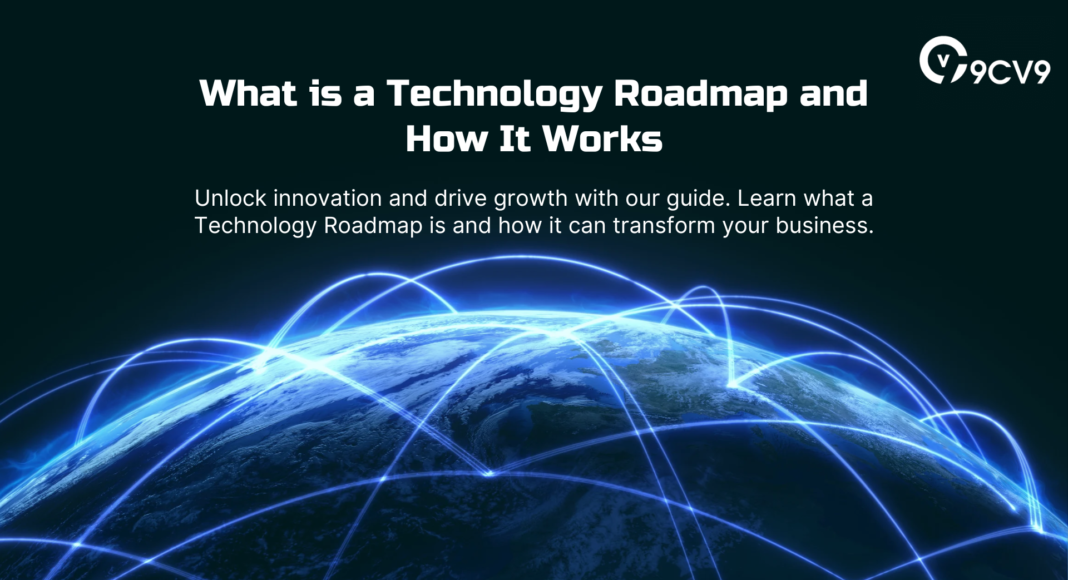Key Takeaways
- Strategic Alignment: Discover how Technology Roadmaps align technology initiatives with business objectives, fostering strategic growth and innovation.
- Collaboration and Communication: Learn how Technology Roadmaps promote collaboration and communication across teams, driving organizational alignment and buy-in.
- Risk Mitigation and Adaptability: Explore how Technology Roadmaps enable organizations to mitigate risks, adapt to change, and drive continuous improvement in a dynamic business landscape.
In the dynamic landscape of technological advancement, businesses face an ever-pressing need to stay ahead of the curve.
But how can organizations navigate the complex terrain of innovation while ensuring strategic alignment, resource optimization, and risk mitigation?
The answer lies in a powerful strategic tool: the Technology Roadmap.

In this comprehensive guide, we embark on a journey to unravel the mysteries surrounding Technology Roadmaps, delving into their intricacies, functionalities, and profound impact on business success.
Whether you’re a seasoned executive striving to optimize your company’s innovation pipeline or an aspiring entrepreneur seeking to chart a clear path toward technological advancement, this exploration will equip you with the knowledge and insights needed to navigate the realm of Technology Roadmaps with confidence and clarity.
So, what exactly is a Technology Roadmap, and how does it work?
At its essence, a Technology Roadmap serves as a strategic blueprint that outlines the trajectory of technological development within an organization.
It provides a structured framework for aligning technology initiatives with business objectives, facilitating communication and collaboration across departments, and guiding decision-making processes from conception to execution.
Picture it as a GPS for innovation, offering a detailed map of the terrain ahead, complete with milestones, timelines, and potential obstacles.
By leveraging a Technology Roadmap, businesses can not only anticipate market trends and emerging technologies but also proactively plan for resource allocation, manage risks, and foster a culture of innovation that propels them ahead of the competition.
But the concept of Technology Roadmaps goes beyond mere planning; it embodies a strategic mindset that drives continuous improvement and adaptation in response to evolving market dynamics and internal capabilities.
Through iterative cycles of assessment, planning, execution, and evaluation, organizations can refine their Technology Roadmaps to stay agile, responsive, and resilient in the face of change.
In the pages that follow, we’ll embark on a comprehensive exploration of Technology Roadmaps, starting with a foundational understanding of their components and types.
We’ll examine real-world case studies of companies that have successfully implemented Technology Roadmaps to drive innovation and achieve strategic goals.
We’ll also delve into the challenges and best practices associated with Technology Roadmap implementation, equipping you with actionable insights to overcome obstacles and maximize success.
Whether you’re a seasoned professional seeking to optimize your organization’s innovation strategy or a curious newcomer eager to grasp the fundamentals of Technology Roadmaps, this guide is your roadmap to success.
So buckle up, and let’s embark on a journey of discovery, innovation, and transformation as we uncover the power of Technology Roadmaps and how they work.
Before we venture further into this article, we like to share who we are and what we do.
About 9cv9
9cv9 is a business tech startup based in Singapore and Asia, with a strong presence all over the world.
With over eight years of startup and business experience, and being highly involved in connecting with thousands of companies and startups, the 9cv9 team has listed some important learning points in this overview of What is a Technology Roadmap and How It Works.
If your company needs recruitment and headhunting services to hire top-quality employees, you can use 9cv9 headhunting and recruitment services to hire top talents and candidates. Find out more here, or send over an email to [email protected].
Or just post 1 free job posting here at 9cv9 Hiring Portal in under 10 minutes.
What is a Technology Roadmap and How It Works
- Understanding the Concept of Technology Roadmaps
- Importance of Technology Roadmaps
- How Technology Roadmaps Work
- Challenges and Best Practices
1. Understanding the Concept of Technology Roadmaps
In today’s fast-paced digital landscape, understanding the concept of Technology Roadmaps is crucial for organizations aiming to harness innovation and drive strategic growth.
Let’s delve deeper into the intricacies of Technology Roadmaps, exploring their components, types, and real-world applications.
What Constitutes a Technology Roadmap?
- Vision and Goals: At the core of every Technology Roadmap lies a clear vision and well-defined goals that align with the organization’s strategic objectives. This includes outlining the desired outcomes, such as product enhancements, market expansion, or technological advancements.
- Current State Assessment: Before charting a course for the future, it’s essential to assess the organization’s current technological landscape. This involves evaluating existing capabilities, identifying strengths and weaknesses, and understanding market trends and competitive pressures.
- Future State Vision: A Technology Roadmap articulates a compelling vision of the future, depicting how technology will evolve to support the organization’s goals and aspirations. This may include adopting emerging technologies, enhancing product features, or optimizing internal processes.
- Key Milestones and Timelines: To transform vision into reality, Technology Roadmaps delineate key milestones and timelines for achieving strategic objectives. This includes setting realistic deadlines, prioritizing initiatives, and allocating resources effectively.
- Resource Allocation: Successful execution of a Technology Roadmap hinges on prudent resource allocation, encompassing financial investments, human capital, and technological infrastructure. This involves optimizing resource utilization to maximize ROI and minimize risks.
- Risk Assessment and Mitigation Strategies: Anticipating and mitigating risks is integral to the success of any technology initiative. Technology Roadmaps incorporate risk assessment frameworks and mitigation strategies to address potential challenges, such as technical hurdles, market volatility, or regulatory changes.
- Stakeholder Engagement: Collaboration and communication are essential components of Technology Roadmaps. Engaging stakeholders across the organization fosters buy-in, promotes alignment, and ensures that diverse perspectives are considered in the decision-making process.
Types of Technology Roadmaps
- Product Technology Roadmaps: These roadmaps focus on the development and evolution of specific products or services. For example, a software company may create a Product Technology Roadmap to outline the features and functionalities of its flagship product over time, taking into account customer feedback and market trends.
- Corporate Technology Roadmaps: Corporate Technology Roadmaps encompass a broader scope, aligning technology initiatives with the organization’s overall strategic direction. This may include investments in infrastructure, R&D projects, digital transformation initiatives, and strategic partnerships.
- Infrastructure Technology Roadmaps: Infrastructure Technology Roadmaps pertain to the underlying technological infrastructure that supports the organization’s operations. This could involve upgrading hardware, migrating to cloud-based solutions, enhancing cybersecurity measures, or implementing IoT systems.
- Market Technology Roadmaps: Market Technology Roadmaps focus on anticipating and responding to market trends, customer demands, and competitive dynamics. Organizations use these roadmaps to identify emerging technologies, assess market opportunities, and position themselves for long-term success.
Relevant Examples:
- Apple’s Product Technology Roadmap: Apple is renowned for its meticulous product roadmap, exemplified by the iPhone’s evolution over the years. Each new iteration of the iPhone incorporates innovative features and design enhancements, guided by Apple’s long-term vision for mobile technology.
- Amazon’s Corporate Technology Roadmap: Amazon’s corporate roadmap encompasses a wide array of technology initiatives, including e-commerce innovations, cloud computing services (AWS), logistics optimization, and AI-driven personalization. This holistic approach enables Amazon to maintain its competitive edge across diverse business verticals.
- Google’s Infrastructure Technology Roadmap: Google’s infrastructure roadmap focuses on enhancing the scalability, reliability, and performance of its global network infrastructure. This includes investments in data centers, fiber-optic networks, and edge computing technologies to support the growing demands of its services, such as Google Search, YouTube, and Google Cloud Platform.

By understanding the nuances of Technology Roadmaps and their diverse applications, organizations can gain a strategic advantage in today’s digital economy, driving innovation, fostering agility, and achieving sustainable growth.
2. Importance of Technology Roadmaps
In a rapidly evolving technological landscape, the importance of Technology Roadmaps cannot be overstated.
These strategic tools play a pivotal role in guiding organizations through the complexities of innovation, aligning technology initiatives with business objectives, and fostering sustainable growth.
Let’s explore the multifaceted importance of Technology Roadmaps in greater detail.
Strategic Planning and Alignment
- Alignment with Business Objectives: Technology Roadmaps serve as a bridge between technology and business strategy, ensuring that technological initiatives are aligned with the organization’s overarching goals and objectives.
- Long-term Vision: By articulating a clear vision of the future, Technology Roadmaps enable organizations to anticipate market trends, identify emerging opportunities, and position themselves for long-term success.
- Prioritization of Initiatives: Technology Roadmaps help prioritize initiatives based on their strategic importance, resource requirements, and potential impact on business outcomes. This ensures that limited resources are allocated to projects that deliver the highest value.
Communication and Collaboration
- Cross-functional Collaboration: Technology Roadmaps facilitate collaboration and communication across different departments and stakeholders within the organization. This fosters alignment, promotes shared understanding, and enhances decision-making processes.
- Transparency and Accountability: By providing visibility into the organization’s technology initiatives and strategic priorities, Technology Roadmaps promote transparency and accountability at all levels. This encourages proactive problem-solving, fosters a culture of ownership, and minimizes siloed thinking.
- Stakeholder Engagement: Engaging stakeholders throughout the roadmap development process fosters buy-in, generates valuable feedback, and ensures that diverse perspectives are considered. This increases the likelihood of successful implementation and adoption of technology initiatives.
Risk Management and Resource Allocation
- Risk Identification and Mitigation: Technology Roadmaps incorporate risk assessment frameworks and mitigation strategies to identify potential obstacles and challenges. By proactively addressing risks, organizations can minimize disruptions, safeguard investments, and enhance project success rates.
- Optimized Resource Allocation: Efficient resource allocation is essential for maximizing return on investment and minimizing waste. Technology Roadmaps provide a structured framework for allocating resources, including financial capital, human resources, and technological infrastructure, based on strategic priorities and anticipated outcomes.
- Flexibility and Adaptability: In today’s dynamic business environment, agility is paramount. Technology Roadmaps enable organizations to adapt to changing market conditions, emerging technologies, and evolving customer preferences while staying aligned with overarching strategic objectives.
Innovation and Competitive Advantage
- Driving Innovation: Technology Roadmaps serve as a catalyst for innovation by providing a structured framework for exploring new ideas, experimenting with emerging technologies, and driving continuous improvement. This enables organizations to stay ahead of the curve and capitalize on market opportunities.
- Enhancing Competitive Advantage: In a competitive marketplace, the ability to innovate quickly and effectively can be a significant source of competitive advantage. Technology Roadmaps empower organizations to differentiate themselves through innovative products, services, and business models, thereby gaining a foothold in the market and driving sustainable growth.
Relevant Examples:
- Tesla’s Technology Roadmap: Tesla’s strategic roadmap encompasses a bold vision for the future of transportation, including the development of electric vehicles, renewable energy solutions, and autonomous driving technology. By aligning its technological initiatives with long-term sustainability goals, Tesla has positioned itself as a leader in the automotive industry and a pioneer in clean energy innovation.
- Netflix’s Content Technology Roadmap: Netflix’s content technology roadmap is focused on leveraging data analytics, machine learning, and personalized recommendations to enhance the user experience and drive subscriber growth. By continuously innovating and refining its content delivery platform, Netflix has become a dominant player in the streaming industry, disrupting traditional media models and reshaping consumer behavior.

In summary, Technology Roadmaps play a pivotal role in shaping the future trajectory of organizations, enabling them to navigate the complexities of innovation, drive strategic alignment, mitigate risks, and gain a competitive edge in today’s digital economy.
By embracing Technology Roadmaps as a strategic tool, organizations can unlock new opportunities, drive sustainable growth, and thrive in an ever-changing business landscape.
3. How Technology Roadmaps Work
Understanding how Technology Roadmaps work is essential for organizations aiming to leverage these strategic tools effectively to drive innovation, manage resources, and achieve strategic goals.
Let’s delve into the intricacies of Technology Roadmaps, exploring their key components, implementation process, and real-world applications.
Initiating the Process: Identifying Needs and Objectives
- Assessment of Current State: The process begins with a comprehensive assessment of the organization’s current technological landscape, including existing capabilities, infrastructure, and areas for improvement.
- Stakeholder Engagement: Engaging key stakeholders from across the organization, including executives, department heads, and subject matter experts, ensures alignment and fosters a shared understanding of strategic priorities and objectives.
- Defining Strategic Goals: Clarifying the organization’s long-term vision, goals, and priorities provides a guiding framework for the development of the Technology Roadmap. This includes identifying key focus areas, such as product innovation, operational efficiency, or market expansion.
Gathering Information and Assessing Current State
- Data Collection: Gathering relevant data and insights from internal and external sources, such as market research, customer feedback, and competitive analysis, provides valuable inputs for roadmap development.
- SWOT Analysis: Conducting a SWOT (Strengths, Weaknesses, Opportunities, Threats) analysis helps identify internal strengths and weaknesses, as well as external opportunities and threats, informing strategic decision-making and risk management.
- Technology Assessment: Assessing the organization’s technological capabilities and readiness helps identify gaps, dependencies, and potential areas for investment or improvement.
Defining Future Vision and Goals
- Vision Statement: Articulating a clear and compelling vision for the future sets the direction and tone for the Technology Roadmap. This vision statement should be aspirational yet achievable, inspiring stakeholders to rally behind common goals.
- Goal Setting: Establishing SMART (Specific, Measurable, Achievable, Relevant, Time-bound) goals ensures that objectives are clear, actionable, and aligned with the organization’s strategic priorities.
- Prioritization: Prioritizing initiatives based on their strategic importance, impact on business outcomes, and resource requirements helps focus efforts and allocate resources effectively.
Mapping Key Milestones and Timelines
- Milestone Definition: Identifying key milestones and deliverables helps break down long-term goals into manageable, actionable steps. This includes setting deadlines, milestones, and checkpoints to track progress and measure success.
- Timeline Development: Developing a realistic timeline for roadmap execution ensures that initiatives are sequenced appropriately and resources are allocated efficiently. This involves balancing ambitious goals with practical constraints, such as budgetary limitations and resource availability.
- Dependencies and Interdependencies: Identifying dependencies and interdependencies between different initiatives helps mitigate risks and ensure smooth execution. This involves understanding the relationships between various projects, tasks, and stakeholders and planning accordingly.
Allocating Resources and Assessing Risks
- Resource Allocation: Allocating resources, including financial capital, human resources, and technological infrastructure, based on strategic priorities and anticipated outcomes ensures optimal resource utilization and ROI.
- Risk Assessment: Identifying potential risks, such as technical hurdles, market volatility, or regulatory changes, helps mitigate threats and minimize disruptions to roadmap execution. This involves conducting risk assessments, scenario planning, and implementing risk mitigation strategies.
- Contingency Planning: Developing contingency plans and fallback options helps organizations respond effectively to unforeseen challenges and disruptions, ensuring continuity and resilience in the face of uncertainty.
Engaging Stakeholders and Maintaining Communication
- Stakeholder Engagement: Engaging stakeholders throughout the roadmap development process fosters buy-in, generates valuable feedback, and ensures that diverse perspectives are considered. This increases the likelihood of successful implementation and adoption of technology initiatives.
- Communication Plan: Developing a robust communication plan ensures that stakeholders are kept informed and engaged throughout the roadmap execution process. This includes regular updates, progress reports, and opportunities for feedback and collaboration.
- Change Management: Anticipating and managing organizational change is essential for successful roadmap implementation. This involves addressing resistance, fostering a culture of adaptability, and providing support and resources to facilitate transition.
Implementing and Monitoring Progress
- Execution and Implementation: Executing the Technology Roadmap involves translating strategic plans into actionable initiatives, assigning responsibilities, and mobilizing resources to drive progress. This requires effective project management, coordination, and collaboration across teams and departments.
- Performance Monitoring: Monitoring progress against key milestones, KPIs (Key Performance Indicators), and success criteria helps track performance, identify areas for improvement, and make informed decisions. This involves establishing metrics, collecting data, and analyzing results on an ongoing basis.
- Course Correction: Flexibility and adaptability are essential for navigating unforeseen challenges and changes in the business environment. Technology Roadmaps should be dynamic and responsive, allowing for course correction and adjustment as needed to stay aligned with strategic objectives.
Relevant Examples:
- Microsoft’s Cloud Technology Roadmap: Microsoft’s cloud technology roadmap outlines a strategic vision for the evolution of its Azure cloud platform, including investments in infrastructure, AI capabilities, and industry-specific solutions. By aligning its technology roadmap with market trends and customer needs, Microsoft has maintained its leadership position in the cloud computing market.
- Toyota’s Sustainable Mobility Roadmap: Toyota’s sustainable mobility roadmap encompasses a long-term vision for the development of electric vehicles, hydrogen fuel cell technology, and autonomous driving systems. By investing in green technology and innovation, Toyota aims to address environmental challenges while maintaining its competitive edge in the automotive industry.

In summary, Technology Roadmaps provide a structured framework for aligning technology initiatives with strategic objectives, fostering collaboration and communication, and driving continuous improvement and innovation.
By understanding how Technology Roadmaps work and implementing best practices, organizations can navigate the complexities of technological innovation and achieve sustainable growth and success.
4. Challenges and Best Practices
Navigating the development and execution of Technology Roadmaps can pose various challenges for organizations, from stakeholder alignment to resource allocation.
However, implementing best practices can help mitigate these challenges and maximize the effectiveness of Technology Roadmaps.
Let’s explore some common challenges and best practices in greater detail.
Common Challenges in Implementing Technology Roadmaps
- Lack of Stakeholder Buy-In: Gaining buy-in from key stakeholders across the organization can be challenging, particularly if there are competing priorities or resistance to change. This can hinder the implementation of Technology Roadmaps and lead to delays or roadblocks.
- Resource Constraints: Limited resources, including financial capital, human resources, and technological infrastructure, can pose significant challenges to roadmap execution. Organizations may struggle to allocate resources effectively, leading to project delays or compromises in quality.
- Changing Business Environment: Rapidly evolving market conditions, technological advancements, and regulatory changes can introduce uncertainty and disrupt roadmap execution. Organizations must remain agile and adaptable to navigate these changes effectively.
- Complexity and Scope: Developing and managing Technology Roadmaps for complex projects or initiatives with multiple dependencies and interdependencies can be daunting. Organizations may struggle to maintain visibility and control over all aspects of the roadmap, leading to inefficiencies and delays.
Best Practices for Creating and Executing Effective Technology Roadmaps
- Cross-Functional Collaboration: Foster collaboration and communication across different departments and stakeholders within the organization. This ensures alignment, promotes shared understanding, and enhances decision-making processes.
- Clear Communication: Develop a robust communication plan to keep stakeholders informed and engaged throughout the roadmap execution process. Regular updates, progress reports, and feedback mechanisms help maintain transparency and accountability.
- Flexibility and Adaptability: Design Technology Roadmaps with flexibility and adaptability in mind to accommodate changes in market conditions, emerging technologies, and stakeholder priorities. This allows organizations to pivot quickly and adjust course as needed.
- Continuous Evaluation and Improvement: Establish metrics and KPIs to monitor progress against key milestones and success criteria. Regularly evaluate roadmap performance, identify areas for improvement, and make adjustments to optimize outcomes.
Relevant Examples:
- Google’s Agile Approach: Google employs an agile approach to roadmap development and execution, emphasizing flexibility, collaboration, and rapid iteration. Teams work in sprints, focusing on delivering incremental value and responding to changing priorities and customer feedback.
- Apple’s Customer-Centric Strategy: Apple’s customer-centric approach to roadmap development involves closely listening to customer feedback, anticipating needs, and innovating to deliver products and services that delight users. This focus on customer experience drives product differentiation and market success.
By addressing common challenges and implementing best practices, organizations can overcome obstacles and maximize the effectiveness of their Technology Roadmaps.
This allows them to drive innovation, achieve strategic objectives, and maintain a competitive edge in today’s dynamic business environment.
Conclusion
In the ever-evolving landscape of technology and business, the concept of Technology Roadmaps emerges as a beacon of guidance, offering organizations a structured framework to navigate the complexities of innovation, drive strategic alignment, and achieve sustainable growth.
Throughout this comprehensive exploration, we’ve delved into the intricacies of Technology Roadmaps, from their foundational components to real-world applications, challenges, and best practices.
As we draw this journey to a close, let’s recapitulate the key insights and takeaways garnered along the way.
Unlocking Strategic Potential
Technology Roadmaps serve as strategic blueprints, guiding organizations on a transformative journey towards their desired future state.
By articulating a clear vision, defining strategic goals, and mapping key milestones, Technology Roadmaps empower organizations to align technology initiatives with business objectives, prioritize investments, and drive innovation.
Fostering Collaboration and Communication
At the heart of Technology Roadmaps lies the principle of collaboration and communication.
By engaging stakeholders across the organization, fostering transparency, and promoting a culture of collaboration, Technology Roadmaps facilitate alignment, generate buy-in, and ensure that diverse perspectives are considered in decision-making processes.
Mitigating Risks and Maximizing Opportunities
In a landscape fraught with uncertainty, Technology Roadmaps provide a structured framework for risk management and resource allocation.
By identifying potential obstacles, assessing risks, and implementing mitigation strategies, organizations can minimize disruptions, safeguard investments, and capitalize on emerging opportunities.
Embracing Agility and Adaptability
Flexibility and adaptability are hallmarks of successful Technology Roadmaps.
In a rapidly changing business environment, organizations must remain agile, responsive, and open to course correction.
By embracing iterative cycles of evaluation, refinement, and adaptation, Technology Roadmaps enable organizations to stay ahead of the curve and pivot quickly in response to evolving market dynamics.
Driving Continuous Improvement
Continuous improvement lies at the core of Technology Roadmaps.
By establishing metrics, monitoring progress, and evaluating outcomes, organizations can identify areas for optimization, iterate on their strategies, and drive sustainable growth.
This commitment to learning and refinement ensures that Technology Roadmaps remain dynamic, relevant, and effective over time.
Looking to the Future
As we peer into the future, the importance of Technology Roadmaps will only continue to grow.
In an era defined by rapid technological advancements, disruptive innovations, and evolving customer expectations, organizations must harness the power of Technology Roadmaps to navigate the complexities of change, drive strategic transformation, and unlock new opportunities for growth and success.
In closing, Technology Roadmaps stand as a testament to the power of strategic planning, collaboration, and innovation in shaping the future of organizations.
By embracing the principles and best practices outlined in this guide, organizations can chart a clear path forward, harnessing the transformative potential of Technology Roadmaps to achieve their most ambitious goals and aspirations.
If your company needs HR, hiring, or corporate services, you can use 9cv9 hiring and recruitment services. Book a consultation slot here, or send over an email to [email protected].
If you find this article useful, why not share it with your hiring manager and C-level suite friends and also leave a nice comment below?
We, at the 9cv9 Research Team, strive to bring the latest and most meaningful data, guides, and statistics to your doorstep.
To get access to top-quality guides, click over to 9cv9 Blog.
People Also Ask
What is a Technology Roadmap?
A Technology Roadmap is a strategic plan outlining an organization’s vision for technology development. It aligns tech initiatives with business goals, guiding innovation and growth.
How does a Technology Roadmap work?
A Technology Roadmap works by defining goals, assessing current capabilities, and mapping out key milestones. It fosters collaboration, manages risks, and drives continuous improvement.
What are the key components of a Technology Roadmap?
Key components include vision and goals, current state assessment, future vision, milestones, resource allocation, risk assessment, and stakeholder engagement.
Why is stakeholder engagement important in Technology Roadmaps?
Stakeholder engagement ensures alignment, generates buy-in, and promotes transparency. It fosters collaboration, enhances decision-making, and drives successful implementation.
How does a Technology Roadmap help in strategic planning?
A Technology Roadmap guides strategic planning by aligning technology initiatives with business objectives. It prioritizes investments, mitigates risks, and drives innovation.
What role does collaboration play in Technology Roadmaps?
Collaboration fosters alignment, communication, and shared understanding. It promotes cross-functional teamwork, enhances decision-making, and drives successful execution.
How can Technology Roadmaps drive innovation?
Technology Roadmaps drive innovation by fostering a culture of experimentation, exploration, and adaptation. They prioritize investments, identify opportunities, and drive continuous improvement.
What are the benefits of using a Technology Roadmap?
Benefits include strategic alignment, improved communication, risk mitigation, resource optimization, and driving innovation. It fosters organizational agility and long-term success.
How do Technology Roadmaps help in resource allocation?
Technology Roadmaps optimize resource allocation by prioritizing initiatives based on strategic importance and anticipated outcomes. They ensure efficient use of financial, human, and technological resources.
How do Technology Roadmaps address risks?
Technology Roadmaps address risks by identifying potential obstacles, assessing their impact, and implementing mitigation strategies. They promote proactive risk management and ensure project success.
How often should a Technology Roadmap be updated?
Technology Roadmaps should be updated regularly to reflect changes in market conditions, emerging technologies, and organizational priorities. They should remain dynamic and responsive to evolving needs.
What are the different types of Technology Roadmaps?
Types include product, corporate, infrastructure, and market Technology Roadmaps. Each serves a specific purpose and aligns with different organizational goals and priorities.
How can Technology Roadmaps support project management?
Technology Roadmaps provide a structured framework for project management by defining goals, timelines, and resource allocation. They facilitate coordination, communication, and tracking progress.
How do Technology Roadmaps promote transparency?
Technology Roadmaps promote transparency by providing visibility into the organization’s technology initiatives, strategic priorities, and progress. They foster trust, accountability, and informed decision-making.
What are some common challenges in implementing Technology Roadmaps?
Challenges include stakeholder alignment, resource constraints, changing business environments, complexity, and scope. Overcoming these challenges requires collaboration, adaptability, and effective risk management.
How can organizations overcome stakeholder resistance to Technology Roadmaps?
Organizations can overcome resistance by fostering open communication, addressing concerns, and demonstrating the value of Technology Roadmaps. Engaging stakeholders early and often builds trust and buy-in.
How do Technology Roadmaps promote agility?
Technology Roadmaps promote agility by enabling organizations to adapt to changing market conditions, emerging technologies, and evolving customer needs. They provide a flexible framework for innovation and growth.
What role does data analysis play in Technology Roadmaps?
Data analysis informs decision-making and prioritization in Technology Roadmaps. It provides insights into market trends, customer preferences, and competitive dynamics, guiding strategic planning and execution.
How do Technology Roadmaps drive long-term business growth?
Technology Roadmaps drive long-term growth by aligning technology initiatives with business goals, fostering innovation, and mitigating risks. They provide a roadmap for sustainable development and competitive advantage.
How can organizations ensure successful implementation of Technology Roadmaps?
Successful implementation requires clear communication, stakeholder engagement, effective project management, and a culture of accountability. Continuous evaluation and adaptation are also key to success.
How do Technology Roadmaps contribute to competitive advantage?
Technology Roadmaps contribute to competitive advantage by enabling organizations to differentiate themselves through innovation, efficiency, and agility. They position organizations for long-term success in a dynamic marketplace.
How do Technology Roadmaps support organizational decision-making?
Technology Roadmaps support decision-making by providing a clear framework for prioritization, resource allocation, and risk management. They enable informed decisions aligned with strategic goals and objectives.
What role does leadership play in Technology Roadmap implementation?
Leadership sets the tone, provides direction, and fosters a culture of innovation and collaboration. Strong leadership ensures alignment, accountability, and commitment to Technology Roadmap goals.
How can organizations measure the success of their Technology Roadmaps?
Success can be measured through key performance indicators (KPIs), such as project milestones, ROI, customer satisfaction, and market share. Regular evaluation and feedback help track progress and identify areas for improvement.
How do Technology Roadmaps adapt to changing market conditions?
Technology Roadmaps remain dynamic and responsive to changing market conditions by incorporating feedback, monitoring trends, and adjusting priorities. They enable organizations to pivot quickly and capitalize on emerging opportunities.
How do Technology Roadmaps support digital transformation initiatives?
Technology Roadmaps provide a strategic framework for digital transformation initiatives by aligning technology investments with business objectives. They facilitate organizational change, innovation, and agility in the digital age.
What are some best practices for Technology Roadmap development?
Best practices include stakeholder engagement, clear communication, flexibility, adaptability, continuous evaluation, and alignment with strategic goals. Collaboration, transparency, and accountability are also key to success.
How do Technology Roadmaps drive organizational alignment?
Technology Roadmaps drive organizational alignment by providing a shared vision, clear goals, and a roadmap for execution. They foster collaboration, communication, and accountability across teams and departments.
How do Technology Roadmaps support risk management?
Technology Roadmaps support risk management by identifying potential obstacles, assessing their impact, and implementing mitigation strategies. They provide a structured framework for proactive risk management and decision-making.































![Writing A Good CV [6 Tips To Improve Your CV] 6 Tips To Improve Your CV](https://blog.9cv9.com/wp-content/uploads/2020/06/2020-06-02-2-100x70.png)


